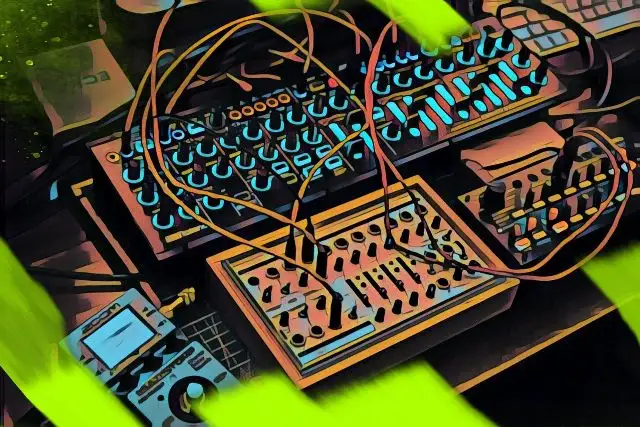Wavetable synthesis is just about everywhere these days, and the design has become a go-to for many synth plugins and digital synthesizers.
Despite its age, it's a powerful synthesis technique that continues to offer a plethora of unique sounds, perfect for bringing a modern twist to your tracks.
In this guide, we’re going to dive in and explore the intricacies of wavetable synthesis, including what it is, how it functions, and what kinds of gear you might want to access its exceptional sound.
Let's begin exploring!
What Is Wavetable Synthesis?
Wavetable synthesis is a unique digital sound synthesis technique that produces an oscillator signal by cycling through a table of waveform-represented values to generate periodic waveforms of varying frequencies.
You might be thinking, "wow, that sounds incredibly complicated," but don't worry, I'll break it down!
However, before I do, I think it's important to have a grasp on the fundamentals of subtractive synthesis .
Take a look at the diagram below to refresh yourself:
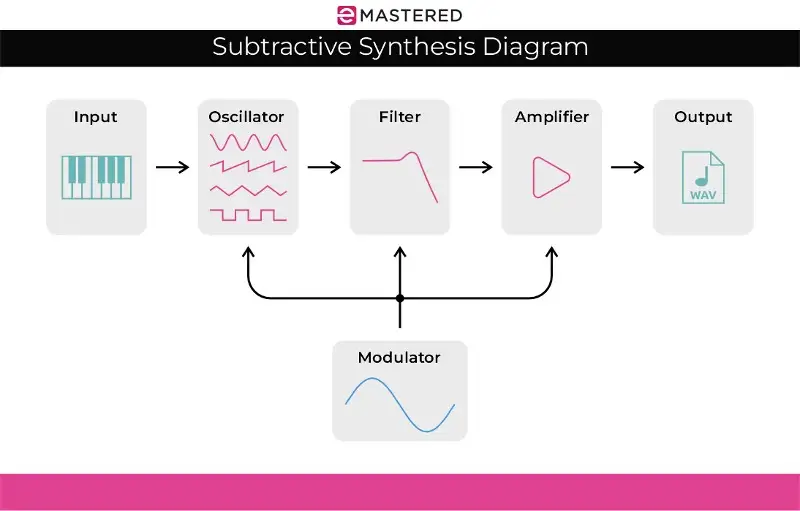
If you look at the diagram above, you'll see the "oscillator" component. In subtractive synthesis, that's an analog VCO (voltage-controlled oscillator).
The traditional VCO in an analog synthesizer is replaced by a wavetable oscillator in a wavetable synth. Unlike analog components that produce fundamental waveforms, wavetable synths rely on a series of values stored in a table.
To illustrate, let's say you have a sawtooth wave. That wave may come from a file in a table comprising 128 entries, each of the entries denoting an amplitude value for a specific wave segment.
The History of Wavetable Synthesis
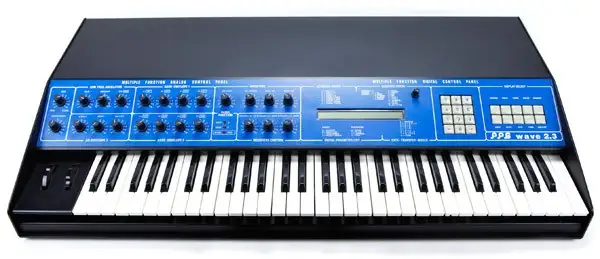
During the advent of digital synthesis in the 1980s, we saw the emergence of wavetable synthesis, pioneered by PPG founder Wolfgang Palm.
With the release of the PPG Wave in 1981, the synthesis landscape underwent a significant shift, as the Wave paired a unique digital synthesis engine with an analog filter, resulting in a blend of analog warmth and boundary-pushing digital innovation.
The Wave found its place in the synth-pop genre of that era and remains a revered instrument among enthusiasts today.
Over the next few decades, several synths received updates, showcasing new wavetable synthesis possibilities.
These included the short-lived 1986 Prophet VS by Sequential Circuits and the 1990 Korg Wavestation.
Then, we had the great Waldorf Music, which was established in 1993 by the German distributor of PPG.
This company emerged as one of the top manufacturers of hardware wavetable synths. If you look at the current landscape, it's easy to see that hardware units are favored by modern producers. The Waldorf Blofeld is an incredibly affordable option that has found its way into many home studios.
Of course, there's no doubt that software revolutionized wavetable synthesis, giving it a new lease on life.
Why Use Wavetable Synthesis
Although it shares some similarities with subtractive synthesis, wavetable synthesis offers a wider range of starting wavetable oscillators compared to your traditional VCO-style oscillators.
Luckily, you can still manipulate your sound's amplitude envelope with ADSR and shape its frequency balance with a filter, which is great if you're already comfortable with the basics of synth sound design. This familiar synthesis style makes wavetable synthesis super accessible.
Plus, the abundance of starting oscillator shapes available in wavetable synthesis allows for more complex, asymmetrical waveforms, giving you near-infinite possibilities for patch creation and sound design.
So, why would one choose to use wavetable synthesizers over other types of synths?
Here's a few reasons:
- More Complex Waveforms - Wavetable synthesis offers a wider range of starting oscillator shapes compared to other types of synthesis, making it easier to create complex and unique waveforms.
- Versatility - The range of sounds you can create with wavetable synthesis is staggering, whether you want simple analog-style sounds or complex evolving textures and soundscapes.
- Efficiency - In the digital world, wavetable synthesis has the ability to produce high-quality sounds using relatively low CPU power, making it ideal for modern-day laptop producers.
- Digital Precision - Wavetable synthesis is entirely digital, meaning you get total control over every aspect of the sound.
- Ability to Combine - Wavetable synthesis can be combined with other types of synthesis, from subtractive to FM synthesis, allowing you to broaden your sound design possibilities.
- Perfect for Modern Electronic Music - With its ability to create complex and evolving sounds, wavetable synthesis is perfect for modern electronic music genres such as dubstep, trap, and techno.
PRO TIP: Try using automation to modulate the wavetable position to create a sense of movement in your music. I love this technique for creating evolving soundscapes and complex textures with constantly shifting timbres.
The Best Wavetable Synth VSTs
1. Waldorf Blofeld
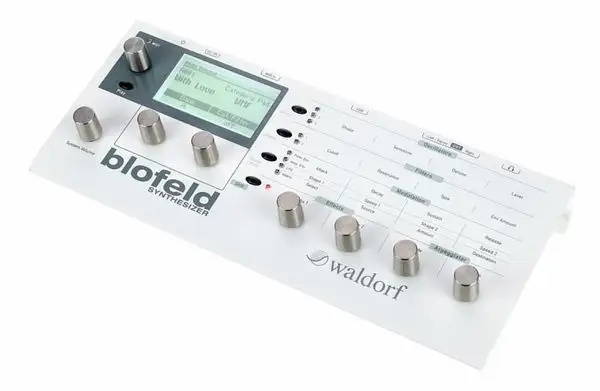
First up on our list is one of the most iconic wavetable synths of all time.
Waldorf, as I mentioned earlier, is a legendary synth builder with a rich history in wavetable synthesis. The company has crafted some of the most legendary wavetable synths in the industry.
One of their most popular modern offerings is the Blofeld , and while this hardware synth may be a little older than some of its counterparts, it still packs a punch when it comes to flexible wavetable patch design.
One of my absolute favorite things about the Blofeld is its one-0f-a-kind comb filter, perfect for stepping into the realm of uncharted physical modeling.
With the Blofeld, Waldorf proves once again that they are a force to be reckoned with in the world of synthesis.
2. Xfer Serum
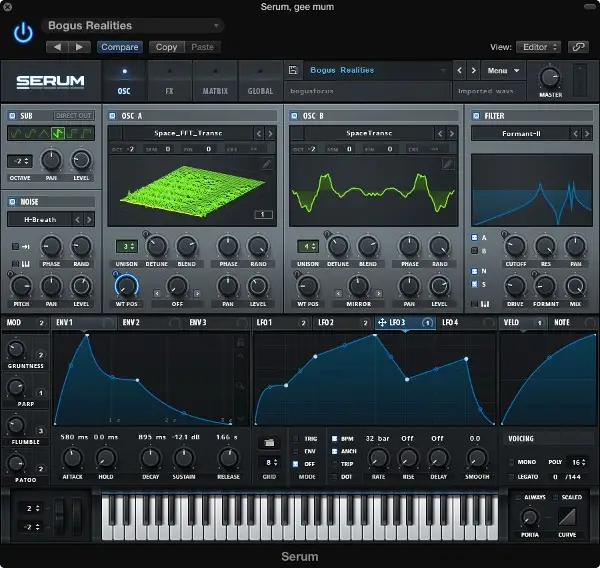
Xfer Serum has quickly become somewhat of a go-to software wavetable synth for electronic producers thanks to its massive sound and undeniable flexibility.
While I could go on for hours talking about the ins and outs of Serum, what I truly want to shine a light on is the Serum community. This thriving hub of power users offers tutorials and preset packs, helping other burgeoning producers unlock the full potential of what might be one of the most powerful tools in EDM.
Whether you're just starting out or a seasoned pro, Serum has all the tools you need to take your sound to the next level.
3. Arturia Pigments
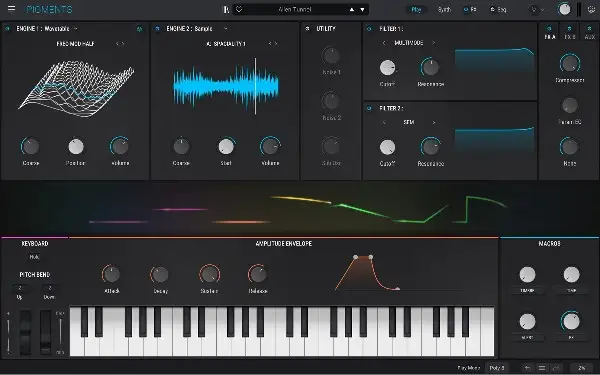
Arturia Pigments is not just another run-of-the-mill software synth. It is a true powerhouse of sound design, combining multiple synthesis methods to create unique and vibrant sonic textures.
Perhaps the most impressive aspect of Pigments is its wavetable engine, which boasts a staggering 160 wavetables that can be morphed, manipulated, animated, and distorted in ways that defy imagination.
It's a veritable playground for the most adventurous sound designers.
Plus, with the ability to blend wavetable and virtual analog synthesis with a massive array of modulation sources and destinations, the sonic possibilities are virtually endless.
Creating Your Own Sounds with Wavetable Synthesis
If you're new to wavetable synthesis, I recommend using presets to your advantage. You can always reverse-engineer them to get a better idea of how they work.
However, when you're ready to explore new sonic territories and create your own unique wavetable sounds from scratch, here are a few step-by-step guides to get you started.
While I'm going to use Native Instruments Massive X for these examples, you can translate the steps to whatever wavetable synth you're working with.
Complex and Evolving Pad
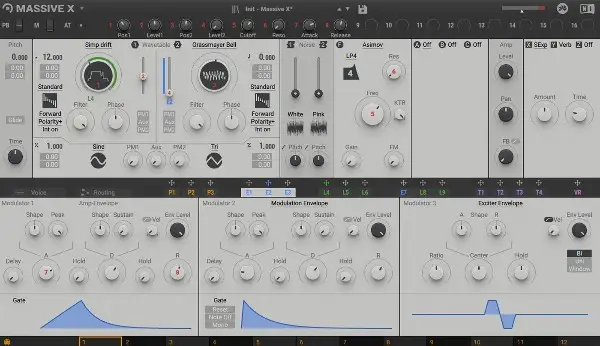
- Open up Your Wavetable Synthesizer - Start by initializing a new patch with a wavetable oscillator as your starting point.
- Select the Right Wavetable - For a complex pad, we'll want to start with a wavetable that has rich harmonic content, such as a complex waveform with multiple harmonics.
- Auto Modulation - Set up the wavetable oscillator to modulate its wave position over time. To do so, you can assign an LFO or envelope to modulate the wavetable position parameter.
- Add a Second Oscillator - To create a more complex sound, choose a different wavetable with complementary harmonic content to the first oscillator.
- Auto Modulate Once More - Modulate the second oscillator's wave position as well. However, the key here is to choose a different rate or depth than the first oscillator.
- Filter - Add a low-pass filter to the overall sound and adjust the cutoff frequency to taste. This will help to tame any harsh high-frequency content and create a smoother, more ethereal pad sound.
- Give the Filter Movement - Assign an envelope to the filter cutoff frequency so that it evolves over time.
- Make the Sound Three-Dimensional - Add some reverb and delay to create a sense of space and depth. Adjust the decay and feedback parameters of the effects to your liking.
- Get Experimental - Experiment with different wavetables, modulation sources, and effects to spice up the sound of your evolving pads.
Gritty Distorted Basslines
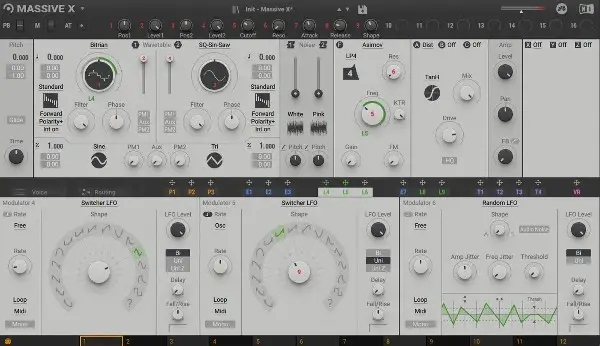
- Select the Right Starting Waveform - Begin by selecting a wavetable with a rich and complex harmonic structure. Go for one that has plenty of closely-spaced harmonics for a grittier and more aggressive sound. Massive X certainly has no shortage of these, though you'll find plenty in wavetable synths like Xfer Serum and Arturia Pigments as well.
- Go Mono - Set the oscillator to play monophonically. You want to ensure your bassline only plays one note at a time. Depending on the sound of the wavetable, you can then lower the pitch of your sound by anywhere from one to a few octaves until it's in the proper bass range.
- Distort It - Add some distortion to make the sound more aggressive. Massive X has some great built-in distortion effects, though you can also use a third-party distortion plugin if yours doesn't. I often like to experiment with different types of distortion until I find the right one. I love the analog-style distortion from Soundtoys Decapitator, though I've also found myself playing around with the MDMX bundle from Waves a lot lately.
- Modulate It - To make your bassline move and feel less sterile, you can add modulation to the wavetable position or wavetable index. This will make the sound shift and morph over time, giving you a more interesting-sounding bassline. While you can certainly automate the LFO to modulate your bass, if you want to be really precise, you can draw in automation curves by hand. This is great for that dubstep-like wobble bass sound.
- Don't Shy Away from Effects - Depending on your mix, you can add some effects to help your bassline sit better. Beginner producers often fear the idea of adding reverb to bass, though if you listen to some of your favorite electronic mixes, you can hear the space and depth that reverb provides, especially in sparser tracks. I sometimes find that a bit of analog-style compression, such as an 1176, can help to tighten up the sound and make it punchier. Feel free to experiment with other effects, such as chorus or delay, as well.
Bright, Glassy Leads
- Select the Right Wavetable - Find a wavetable with bright and rich harmonic content. As you flip through your wavetables, listen for ones with lots of high-end sparkle and presence. Don't be afraid to layer multiple wavetables to create a more complex sound if you need.
- Modulate It - Get creative with filter modulation to give your lead a bit more movement. I often find myself using an LFO to modulate both the filter cutoff and resonance, so I can automate them throughout my track. Experiment with different modulation rates to dial in the perfect amount of movement.
- Saturate and Distort - Add some grit and edge with saturation or distortion. Depending on the starting sound, you might be able to get away with a subtle amount at first, adjusting to taste based on your mix. Again, experiment with different distortion types until you find the right character for your lead.
- Shape the Sound with an Envelope - Set the attack of the envelope so that it's relatively quick. This will help the sound cut through a denser mix. You can then adjust the decay and release to smoothen out the end.
- Give it Some Space - Finally, add some reverb and delay to make the sound more three-dimensional. Experiment with different types of reverb and delay. If you have a denser mix, try mono reverbs and delays so that your leads take up less real estate.
Unleashing Your Sonic Potential with Wavetable Synthesis
Wavetable sound synthesis has long provided an innovative way to build unique and complex sounds in music production.
That's why you still see so many modern wavetable synths and software synths being used by your favorite electronic musicians.
Make sure to check out some of the wavetable synths above to get started!


